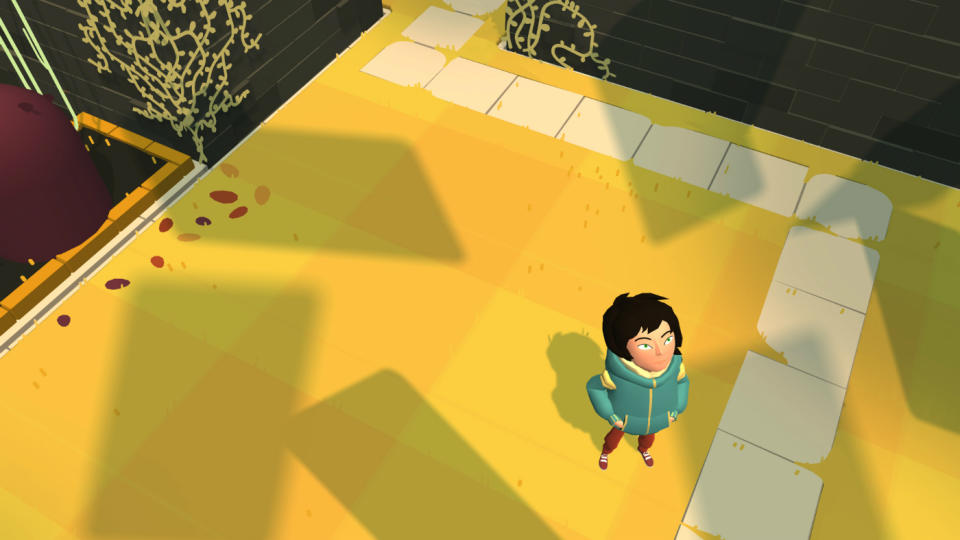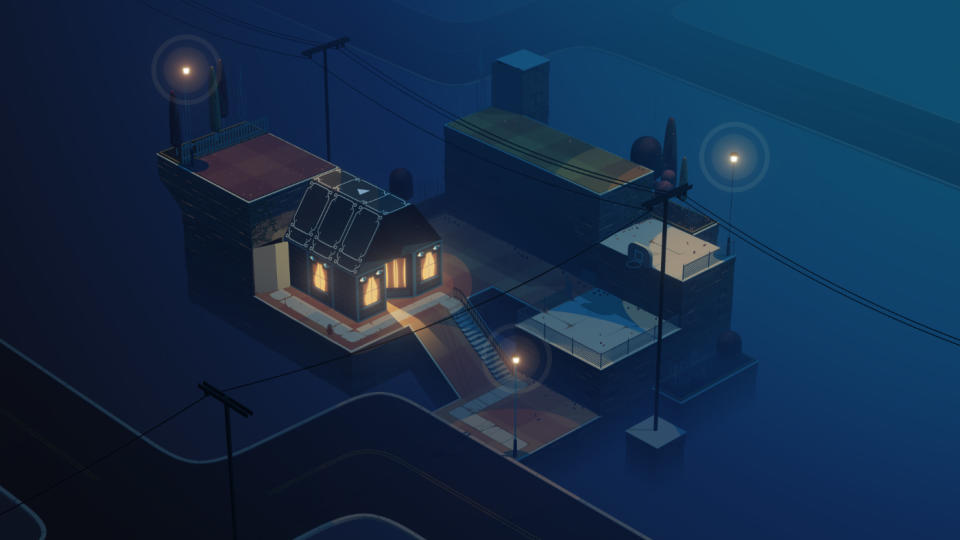The hidden depth of mobile puzzle game 'Where Cards Fall'
'Whatever is in your mind is what we'll honor in the game.'

We're sitting in a circle on the floor of a decadent San Francisco hotel lobby, crowds of people milling around the couches and stairways. The young men of Snowman, the studio behind Alto's Adventure, watch as Sam Rosenthal sets up a small iPad, preparing to show off his latest game, Where Cards Fall. Rosenthal is the co-founder of the Game Band, a small Los Angeles studio working with Snowman to bring its new project to iOS, Apple TV and Steam this autumn.
Rosenthal flips through a slideshow of character designs, explaining the premise as he goes. Where Cards Fall is a top-down, 3D puzzle game that has players build houses of cards to navigate tricky environments. It follows a handful of teenagers over the course of 10 years, from adolescence to college and finally adulthood. The art is cartoonish yet polished, as if the designs of Oxenfree had been transformed into 3D.
Where Cards Fall is primarily a mobile game, but its mechanics and story are deeper than the genre generally suggests. This is why The Game Band teamed up with Snowman, a studio with a history of tapping into the potential of the mobile market.
In Where Cards Fall, the suburbs are filled with rolling hill-like platforms pockmarked with the tops of buildings that look perfect for leaping. Eventually, Rosenthal explains, the characters will leave this area for the cities and eventually the clouds, which are filled with floating houses, winged towns and towering skyscrapers.
For now, though, we're sticking to the suburbs, just 45 minutes into the main game.
Rosenthal loads up the demo and a blaring alarm noise emanates from the iPad. Once the jarring sounds fade away, light music fills the air, a mellow yet bouncy jazz keyboard. A high-school-age character shuffles out of bed in a cheery digital world.
"We're beginning with a section that most of us can relate to: being late for school in the morning," Rosenthal says. "We like to play a bit with walk cycles and animations -- we drastically reduced the speed here to make you really feel like 'Oh, I'm groggy in the morning and not getting it together.' But yeah, the game begins inside of the house of cards. I'll take you outside in a second."
The main character stumbles around the house, pulling on a bright oversize sweater and tight jeans, short brown hair sticking up wildly. I ask what the character's name is.
I don't realize it's a loaded question.
"We actually don't have a name for the main character, and there's a reason for that," Rosenthal says, tapping and dragging away on the screen. "All of our characters are nameless, because we want to tell a story with no dialogue at all to try to make it feel as universal as possible. But with the main character -- this is something we haven't actually talked about too much yet -- but we specifically designed the character to be gender ambiguous so that players can figure out what they think they want the main character to be.
"There's scenes in the game that will be a little bit more gender specific, like the dance and such, and we just let you dress up however you want, take whoever you want. Whatever is in your mind is what we'll honor in the game."

"I see that now," I say. Looking again, the main character is perfectly ambiguous. I mention I had just assumed it was a girl.
"To be honest, it totally just came from our playtesters," Rosenthal says. "We designed the character originally as a different design, and all of our girl playtesters were saying 'she' and all of our guys were saying 'he,' and we decided to run with that design."
Rosenthal taps outside of the house, and the character opens the door. He touches the screen and the character moves toward his finger; he drags it and the character follows the path he's laid out. The keyboard music keeps bopping away, light and contented.
Each platform will have its own unique control mechanic: haptic feedback and 3D touch on the iPhone, possible Touch Bar integration on the Macbook Pro and the ability to play the entire game with the Siri Remote on Apple TV. With the Apple Pencil, players are able to draw a path for their characters to walk down, winding up walkways and around corners. It's specific, direct control. The game itself is seamless, with no distinct levels, which means it supports various play styles -- quick bursts on mobile or longer play sessions at home.
On-screen, Rosenthal's character is standing in the middle of a friendly, sunny day. He needs to get the character to a high-up platform, which means it's time to start building some houses.

"The houses of cards do a lot of different things in this game," Rosenthal says. "Their most primary function is that they can become platforms. You create platforms by spreading out a pile, and when I let go, it turns into a house of cards."
Using his pointer finger and thumb, he picks up a pile of black-backed cards and positions it on the ground. He lets go and a house pops up with a quick shuffling sound, fully formed and ready to move into. But this isn't The Sims, and Rosenthal isn't building houses just for people to live in.
"I'll use this as a bridge now to get further ahead." He jumps to the newly formed rooftop and onto an adjacent platform farther up the path. "I can knock 'em down too. I'll just pinch here." He squeezes the house with his forefinger and thumb and, with a crinkling sound, it collapses back into a black pile.
"One neat thing about them is that I can also make them different sizes," Rosenthal explains. "So if I pinch a little bit smaller, I get a smaller house of cards too." He builds a house in the middle of a large gap. "But this isn't going to help me just yet, because it's still not tall enough. So I'll put a little chimney on it with the other cards I have, and use that to cross."
He pinches, drags and positions a small pile of cards on top of the existing house. It's just enough to allow the main character to cross the gap.
With a shuffling sound, Rosenthal pinches his cards back into a pile. He pulls up a new stack of cards -- the white markings on the back of this one are slightly different from the others he's been using. It's a flat-top, more industrial-style building.

"This is a different type of structure; you can see that with the icon on it," Rosenthal says. There's a quick swoosh-swoosh as he minimizes and expands a handful of buildings, creating makeshift bridges and adorable houses at the same time. He crosses another gap, his character jumping seamlessly from one platform to the next. The jazzy music hums in the background, picking up more sounds as we progress, adding tingling synthetic chimes and percussion.
He pauses the main character on a rooftop and says, "So this level isn't as daunting as it seems. I just have to take it piece by piece." He moves piles of cards around the map, shrinking and expanding them into different sizes, stacking them on top of one another.
Rosenthal sees the paths clearly; he knows exactly where to go. This game is his creation, after all. Every move is obvious to him, and he navigates the game like a magician, seeing opportunities I can't. Where Cards Fall is a decidedly tricky puzzle game, asking players to visualize complicated paths forward and make the most of their physical resources.
From across the circle, Snowman producer Eli Cymet chimes in:
"What I really like about it -- and I've talked to Sam about this a little bit before -- is that when people see screenshots or trailers, I think there's an inclination to say, 'Oh, this is kind of like Monument Valley.' And certainly that's a comparison we're honored to hear, but more actually for us it's kind of like Portal. Because you have to sort of just look at a space and imagine what the movement through that space might be, in your head, and then use the tools you have to create that movement."

Rosenthal agrees.
"Yeah, it's very much a game about spatial awareness and imagining what a space could be. We play with that with the story too. The main character ends up being an architect, which is a profession that very much deals with that as well."
He roams around the level, building more card houses, walking into a coffee shop and hanging out for a quiet moment on a bench, surveying the town. Eventually, a school bus comes into view.
"Now we're starting to see what's actually going on here. You're going to school," Rosenthal says. "A lot of the time in Where Cards Fall, the aim of the characters isn't necessarily clear right at first. We want it to feel like the act of remembering. The puzzle-solving helps with that, but also, when we remember things, I think sometimes we remember what we're doing before why we're doing it. It's kind of meant to seem like that."
I'm not sure why -- perhaps the mention of "school" quietly activates a long-neglected region of my brain -- but I choose this moment, as the demo is wrapping up, to ask if there's a way to die in Where Cards Fall.
"No death at all," Rosenthal says. "It's actually a really fun and interesting design challenge to work on a game where we couldn't use that as an escape. I always feel like it's important to justify any mechanic we include in the game, and if the characters are dying, we'd have to explain in the story why they're dying all the time. We didn't want to do that."

Where Cards Fall prides itself on minimalism and player input. The main character is ambiguous, allowing anyone to project their own psyche onto the model; the world itself is open to exploration without fear of death or a shrinking timer, letting players run wild while they build their card houses. There are no discrete levels and no on-screen prompts directing players along the way.
However, the whole thing comes together beautifully, buoyed by a solid foundation: the puzzles themselves. No matter how fluidly Rosenthal flies through the suburbs, it's clear that these spatial riddles are complicated, requiring multiple steps and the ability to plan ahead. This is a tricky game.
At one point in the middle of the playthrough, Rosenthal pauses for a moment and laughs. "This demo typically takes about half an hour, but I'm just blazing through it."
He pinches and flicks and builds another card house. A new character opens the door from the inside. With a pinch, he collapses the structure and carries on.








